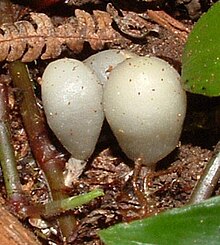Psilocybe weraroa
| Psilocybe weraroa | |
|---|---|

| |
| Scientific classification | |
| Domain: | Eukaryota |
| Kingdom: | Fungi |
| Division: | Basidiomycota |
| Class: | Agaricomycetes |
| Order: | Agaricales |
| Family: | Hymenogastraceae |
| Genus: | Psilocybe |
| Species: | P. weraroa
|
| Binomial name | |
| Psilocybe weraroa Borovička, Oborník &
Noordel. (2011) | |
| Synonyms[1] | |
|
Secotium novae-zelandiae | |
Psilocybe weraroa, formerly Weraroa novae-zelandiae, is a
Taxonomy and naming
The species was first described in the literature in 1924 by the New Zealand-based mycologist
| |||||||||||||||||||||||||||||||||||||||||||||||||||||||||||||||||||||
phylogeny of P. weraroa and related species of Psilocybe. [4]
|
Etymology
The
Description
| Psilocybe weraroa | |
|---|---|
| Glebal hymenium | |
| Cap is conical or ovate | |
| Stipe is bare
or has a saprotrophic | |
| Edibility is psychoactive | |


Habitat and distribution
Solitary to crowded on decaying wood buried in forest leaf litter, often on the rotting branches of Melicytus ramiflorus. It has also been found fruiting on rotted cabbage trees and associated with decaying tree-fern fronds, native to the forests of New Zealand.[9]
Fairly abundant in the early winter and spring months in lowland mixed rainforest near Wellington and Auckland. The mushroom can be difficult to see, often buried under leaves or eaten by slugs, and it is sometimes hard to find mature specimens that are not partially eaten.[9] The species is endemic to New Zealand.[3]
Similar species

Clavogaster virescens is similar in appearance and habitat, but the gleba form a reddish brown chambered mass enclosed inside a sack-like structure within the peridium. The stem is stout, smooth and slippery rather than fibrous, off-white to yellow, enlarged at the top where it often smoothly transitions into the pouch, and tapering towards a yellower base. The fungus does not have a bluing reaction; it is naturally blue to greenish blue, and has no psychoactive properties.[9]
References
- ^ "Psilocybe weraroa Borovička, Oborník & Noordel. 2011". MycoBank. International Mycological Association. Retrieved 2011-07-22.
- ^ "Index Fungorum - Names Record". Index Fungorum. 2011. Archived from the original on 1 October 2021. Retrieved 2 October 2021.
- ^ a b "Psilocybe weraroa Borovička, Oborník & Noordel". NZOR. Archived from the original on 1 October 2021. Retrieved 2 October 2021.
- ^ S2CID 36050854. Archived from the original(PDF) on 2016-03-04. Retrieved 2013-03-01.
- ^ a b Bridge PD, Spooner BM, Beever RE, Park D-C (2008). "Taxonomy of the fungus commonly known as Stropharia aurantiacea, with new combinations inLeratiomyces". Mycotaxon. 103: 109–21. Archived from the original on 2015-09-24. Retrieved 2013-03-02.
- ^ The Tairāwhiti hapū exploring indigenous psilocybin to treat methamphetamine addiction. New Zealand Drug Foundation, 24 May 2023
- ^ Dunne R. Māori group receives first psilocybin cultivation license in NZ to treat substance use disorders. Mugglehead Magazine 30 October 2023
- ^ Hill N (24 April 2024). "Magic mushroom trialled as rongoa to treat addiction and mental health issues". New Zealand Herald.
- ^ a b c d e Cunningham GH (1924). "A critical revision of the Australian and New Zealand species of the genus Secotium". Proceedings of the Linnean Society of New South Wales. 49 (2): 97–119. Retrieved 2023-05-18 – via Manaaki Whenua - Landcare Research (2004) New Zealand Fungi Names Databases.
- ^ Singer R. (1958). "New genera of fungi, IX. The probable ancestor of the Strophariaceae: Weraroa gen. nov". Lloydia. 21: 45–7.
- PMID 12099793.
- ^ Guzmán G, Horak E (1978). "New species of Psilocybe from Papua New Guinea, New Caledonia and New Zealand" (PDF). Sydowia. 31 (1–6): 44–54. Archived (PDF) from the original on 2011-09-29. Retrieved 2011-07-23.
- (PDF) from the original on 2011-10-02. Retrieved 2013-03-01.
Further reading
- "Psilocybe weraroa observations". iNaturalist.
- Werner P (September 2008). "Hey Man, Do they grow any Weraroa around here?". Mycena News – via MykoWeb.
- Whenua N (2022). "Psilocybe weraroa Borov., Oborník & Noordel. 2011". New Zealand Fungi Names Databases. Landcare Research.
External links
 Media related to Psilocybe weraroa at Wikimedia Commons
Media related to Psilocybe weraroa at Wikimedia Commons
